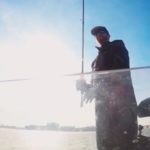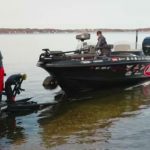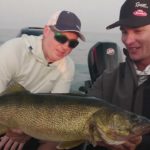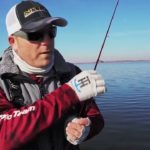Contour Trolling for Post Spawn Walleyes
Think for a second about what’s going in the walleyes world during the early spring. This is the time when walleyes are consumed with the rituals of the spawn. Remember that at any given time during this period, you could have fish in one of three stages pre-spawn, spawn or post-spawn. If that sounds like a factor that makes catching these fish more difficult, think again. It’s all in the mind-set. If you pigeon-hole yourself into thinking that you are going to be forced into finessing fish that have spawning on their mind more than feeding, then chances are you will have tough fishing. However, if you go at it with the attitude that you are fishing for the most active walleyes in the system at any given time, it can actually make things much easier.
Think of it this way; pre-spawn walleyes often stage on the edges of rocky flats, reefs or rip-rap where they will soon move up to conduct their spring ritual. That means there will be large numbers of fish in relatively concentrated areas, which tends to create competition among the fish and makes it a good scenario for a more active presentation. It’s a numbers game the higher the population of fish in a given area, the more likely there will be aggressive individuals in the mix. Now, even though the calendar may say its spring, this is a situation where more summer-like tactics can come in to play.
Total Solutions Technique
While most walleye anglers don’t think about trolling crankbaits in the spring, done right it can be a great presentation. This is not the same as the crankbait trolling that dominates the scene on The Great Lakes in the early season however that’s more of the open water variety of cranking (a subject for yet another article). Here we’re talking about trolling cranks along structure. Again the idea is to cover the edges of structure, be it flats, points, reefs, channel edges, etc. For best results, stick with small, shallow running crankbaits that offer a subtle to moderate action. Since baits such as these are not designed to dive very deep on their own, you’ll need a weighting system in order to get the lures to the desired zone.
Since there are walleyes in all stages of the spawning cycle, they’ll tend to be scattered all along the breaks on the most primo structures. This is a case where trolling with lead core line works like nothing else can. Many of you may think its odd to use lead core this shallow, but in this case its not being used as a weighting system as much as a depth control system. The bulky nature of lead core line gives it a great deal of resistance in the water, which in turn makes it very speed sensitive. That is to say, as you troll along the break, zigging and zagging in order to cover the various depths of the contour, you can control the depth the line runs by simply varying the speed of your boat. It’s like this lets say the top of the break is 5 feet, and the bottom is at 10 feet. Trolling at a speed of 2.8 mph with 40 feet of lead core out, along with a 15 foot leader, the lure will run along just ticking the bottom in 5 feet. As we move down the break we want the lure to follow the contour, so all we need to do is slow down the trolling speed a tad, and gravity takes over, allowing the lead core to pull the lure deeper so that it stays along the bottom. Down the break as we decide to move toward the upper lip again, we simply speed up and the line and lure follow suit.
Total Solutions Equipment
The typical lead core set up for this presentation is made up of an 8 to 8 and a half foot long, medium action trolling rod with a large capacity line-counter reel spooled with 18 pound test lead core. To this you’ll want to connect a 10 to 15 foot leader of a no-stretch line like 10 pound test Berkley FireLine. The no-stretch leader is key, because since lead core has no stretch, it keeps the entire system very sensitive making it possible to monitor the bait’s action right at the rod tip. If the lure is running true, you’ll see the rod tip vibrating. If the lure happens to pick up some debris from the bottom, the rod tip will go dead, alerting you that the lure is fouled and needs checking. Good lure choices for this type of contour trolling would include small shad baits and small minnow-style cranks like the 4cm and 5cm sized Berkley Flicker Shads. This method of contour trolling has proven deadly on many bodies of water throughout the season, and is absolutely worth adding to your arsenal of tricks.





